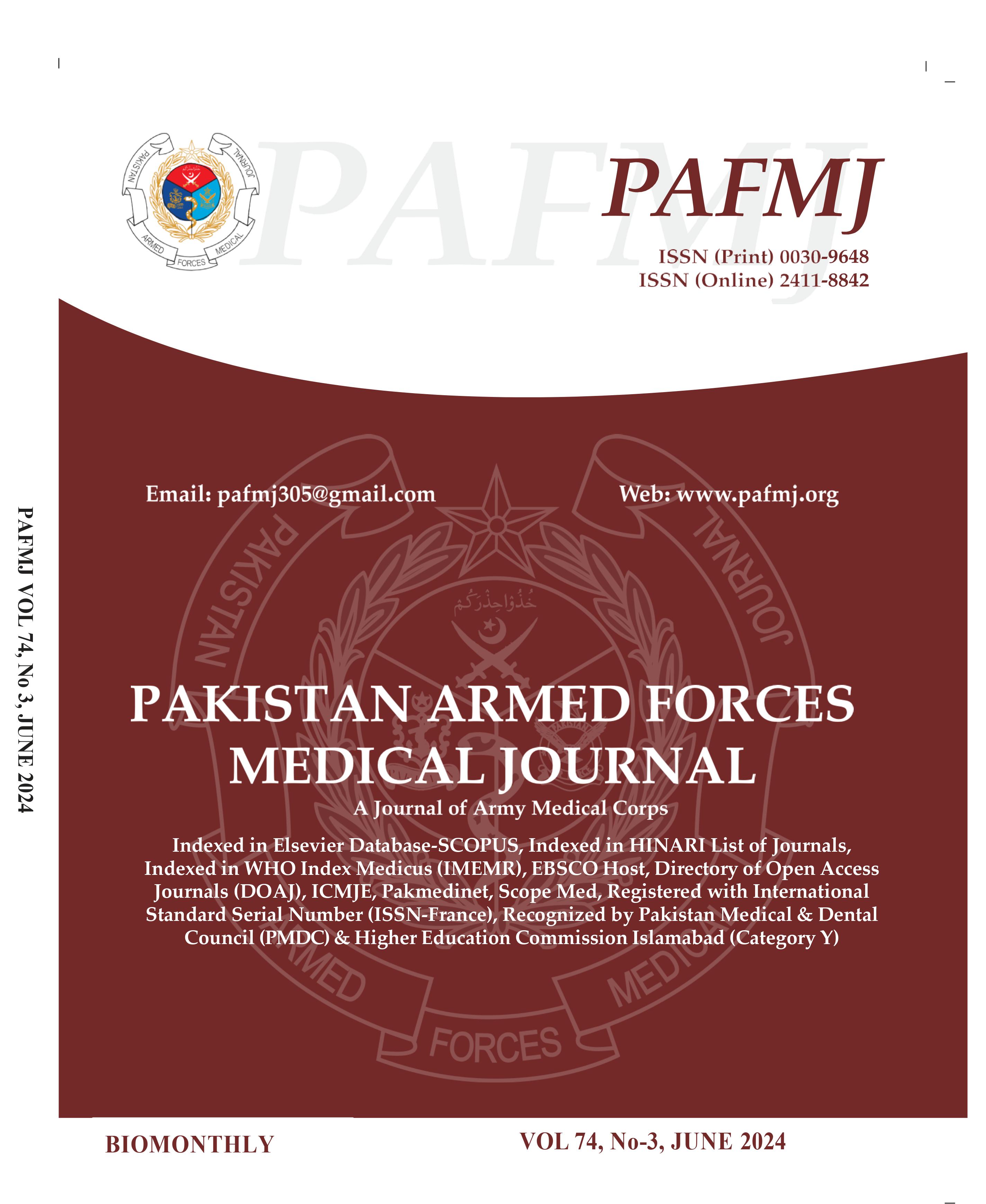Can Dynamic Changes in Inflammatory Markers Predict Outcomes in COVID-19 Infection?
DOI:
https://doi.org/10.51253/pafmj.v74i3.7222Keywords:
COVID-19, Biomarker, Ferritin, MortalityAbstract
Objective: To determine the role of dynamic changes in inflammatory markers over initial 48 hours after admission in predicting outcomes of COVID-19 infection.
Study Design: Cross-sectional study.
Place and Duration of Study: Department of Medicine, Combined Military Hospital, Peshawar Pakistan, from Sep to Dec 2020.
Methodology: Indoor patients with positive polymerase chain reaction test for SARS-CoV-2 were included in the study. Serum C-reactive protein, Ferritin and LDH levels were tested within 60 minutes of admission and the course of these markers was monitored over 48 hrs. In-hospital mortality was also recorded.
Results: There were 92 patients in this study, having a mean age of 53.80±16.20 years. In-hospital, 14 patients (15.22%) died whereas the rest were discharged. Median and interquartile ranges for changes in Serum CRP, Ferritin and LDH over the first 48 hours of admission were -10.00(-56.35–2.68) mg/L, -5.50(-100.00–193.50) ng/ml and -23.50(-162.00–81.50) U/L respectively. Increase in Serum Ferritin ≥128.5 ng/ml had 64.29% sensitivity and 74.36% specificity for predicting in- hospital mortality. Changes in C-reactive protein and Lactate Dehydrogenase did not have a predictive role in our study.
Conclusion: Rise in Serum Ferritin levels over first two days of admission was associated with increased risk of death.
Downloads
References
World Health Organization. WHO Coronavirus (COVID-19)
Dashboard. [Internet]. Available at:
https://data.who.int/dashboards/covid19/cases?n=c
Lingeswaran M, Goyal T, Ghosh R, Suri S, Mitra P, Misra S, et al. Inflammation, immunity and immunogenetics in COVID-19: a narrative review. Indian J Clin Biochem 2020; 35(3): 260-273 http://doi.org/10.1007/s12291-020-00897-3
Cevik M, Kuppalli K, Kindrachuk J, Peiris M. Virology, transmission, and pathogenesis of SARS-CoV-2. BMJ 2020; 371: m3862
https://doi.org/10.1136/bmj.m3862
Abbas S, Hayat A, Majeed N, Jaffar S, Asghar J, Ali S. Comparison of inflammatory markers with different levels of severity of COVID-19 disease. Pak Armed Forces Med J 2020; 70(2): S455-458.
Hariyanto TI, Japar KV, Kwenandar F, Damay V, Siregar JI, Lugito NPH, et al. Inflammatory and hematologic markers as predictors of severe outcomes in COVID-19 infection: A systematic review and meta-analysis. Am J Emerg Med 2021; 41: 110-119. https://doi.org/10.1016/j.ajem.2020.12.076
Leisman DE, Ronner L, Pinotti R, Taylor MD, Sinha P, Calfee CS, et al. Cytokine elevation in severe and critical COVID-19: a rapid systematic review, meta-analysis, and comparison with other inflammatory syndromes. Lancet Respir Med 2020; 8(12): 1233-1244. https://doi.org/10.1016/S2213-2600(20)30404-5
Arshad AR, Khan I, Shahzad K, Arshad M, Haider SJ, Aslam MJ. Association of inflammatory markers with mortality in COVID-19 infection. J Coll Physicians Surg Pak 2020; 30(10): 158-163 https://doi.org/10.29271/jcpsp.2020.10.158
National Institutes of Health. COVID-19 Treatment Guidelines Panel. Coronavirus Disease 2019 (COVID-19) Treatment Guidelines. [Internet]. Available at:
https://www.covid19treatmentguidelines.nih.gov/
[Accessed on December 27, 2020].
Mueller AA, Tamura T, Crowley CP, DeGrado JR, Haider H, Jezmir JL, et al. Inflammatory biomarker trends predict respiratory decline in COVID-19 patients. Cell Rep Med 2020; 1(8): 100144.
https://doi.org/10.1016/j.xcrm.2020.100144
Herold T, Jurinovic V, Arnreich C, Lipworth BJ, Hellmuth JC, von Bergwelt-Baildon M, et al. Elevated levels of IL-6 and CRP predict the need for mechanical ventilation in COVID-19. J Allergy Clin Immunol 2020; 146(1): 128-136.e4.
https://doi.org/10.1016/j.jaci.2020.05.008
Sonnweber T, Boehm A, Sahanic S, Pizzini A, Aichner M, Sonnweber B, et al. Persisting alterations of iron homeostasis in COVID-19 are associated with non-resolving lung pathologies and poor patients’ performance: a prospective observational cohort study. Respir Res 2020; 21: 276.
https://doi.org/10.1186/s12931-020-01546-2
Bozkurt FT, Tercan M, Patmano G, Bingol Tanrıverdi T, Demir HA, Yurekli UF. Can ferritin levels predict the severity of illness in patients with COVID-19? Cureus 2021; 13(1): e12832.
https://doi.org/10.7759/cureus.12832
Lino K, Guimarães GMC, Alves LS, Oliveira AC, Faustino R, Fernandes CS, et al. Serum ferritin at admission in hospitalized COVID-19 patients as a predictor of mortality. Braz J Infect Dis 2021; 25(2): 101569.
https://doi.org/10.1016/j.bjid.2021.101569
Ayanian S, Reyes J, Lynn L, Teufel K. The association between biomarkers and clinical outcomes in novel coronavirus pneumonia in a US cohort. Biomark Med 2020; 14(12): 1091-1097. https://doi.org/10.2217/bmm-2020-0319
Pan F, Yang L, Li Y, Liang B, Li L, Ye T, et al. Factors associated with death outcome in patients with severe coronavirus disease-19 (COVID-19): a case-control study. Int J Med Sci 2020; 17(9): 1281-1292.
https://doi.org/10.7150/ijms.46614
Tan C, Huang Y, Shi F, Tan K, Ma Q, Chen Y, et al. C-reactive protein correlates with computed tomographic findings and predicts severe COVID-19 early. J Med Virol 2020; 92(7): 856-862 https://doi.org/10.1002/jmv.25871
Chen W, Zheng KI, Liu S, Yan Z, Xu C, Qiao Z. Plasma CRP level is positively associated with the severity of COVID-19. Ann Clin Microbiol Antimicrob 2020; 19(1): 18
https://doi.org/10.1186/s12941-020-00344-3
Sharifpour M, Rangaraju S, Liu M, Alabyad D, Nahab FB, Creel-Bulos CM, et al; Emory COVID-19 Quality & Clinical Research Collaborative. C-Reactive protein as a prognostic indicator in hospitalized patients with COVID-19. PLoS One 2020; 15(11): e0242400
https://doi.org/10.1371/journal.pone.0242400
Vidal-Cevallos P, Higuera-De-La-Tijera F, Chávez-Tapia NC, Sanchez-Giron F, Cerda-Reyes E, Rosales-Salyano VH, et al. Lactate-dehydrogenase associated with mortality in hospitalized patients with COVID-19 in Mexico: a multi-centre retrospective cohort study. Ann Hepatol 2021; 24: 100338
https://doi.org/10.1016/j.aohep.2021.100338
Wu MY, Yao L, Wang Y, Zhu XY, Wang XF, Tang PJ, et al. Clinical evaluation of potential usefulness of serum lactate dehydrogenase (LDH) in 2019 novel coronavirus (COVID-19) pneumonia. Respir Res 2020; 21(1): 171.
https://doi.org/10.1186/s12931-020-01427-8
Henry BM, Aggarwal G, Wong J, Benoit S, Vikse J, Plebani M, et al. Lactate dehydrogenase levels predict coronavirus disease 2019 (COVID-19) severity and mortality: A pooled analysis. Am J Emerg Med 2020; 38(9): 1722-1726
https://doi.org/10.1016/j.ajem.2020.05.073
Poggiali E, Zaino D, Immovilli P, Rovero L, Losi G, Dacrema A, et al. Lactate dehydrogenase and C-reactive protein as predictors of respiratory failure in CoVID-19 patients. Clin Chim Acta 2020; 509: 135-138.
Downloads
Published
Issue
Section
License
Copyright (c) 2024 Umama Tahir, Siraj Muhammad, Abdul Rehman Arshad, Muhammad Azam Mallhi, Yumna Tahir

This work is licensed under a Creative Commons Attribution-NonCommercial 4.0 International License.















